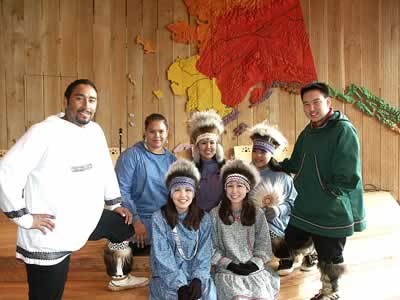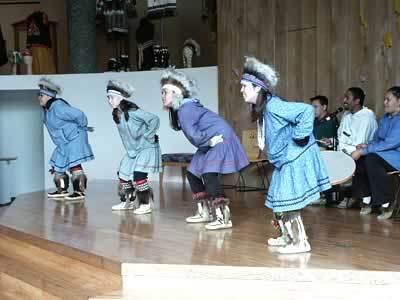|
|
Canku Ota |
|
|
(Many Paths) |
||
|
An Online Newsletter Celebrating Native America |
||
|
June 29, 2002 - Issue 64 |
||
|
|
||
|
Young Dancers Learn and Share Native Dance Traditions |
||
|
|
 Audience
members tentatively approach the stage to ask questions of the young performers.
“How old are you all?” asks an elderly man. “Sixteen,”
four of the dancers answer in unison. Others chime in, “Fifteen.”
“Eighteen.” “Oh my, you’re so young, and so poised.
I really enjoyed your dancing. Thank you.” Audience
members tentatively approach the stage to ask questions of the young performers.
“How old are you all?” asks an elderly man. “Sixteen,”
four of the dancers answer in unison. Others chime in, “Fifteen.”
“Eighteen.” “Oh my, you’re so young, and so poised.
I really enjoyed your dancing. Thank you.”
An elderly woman asks, “Are you all from the same tribe?” A brief smile passes among the dancers. “No, we represent three different cultures,” responds Vernita Bunyan. Pointing to several of her fellow dancers, “We four are Yup’ik. Anesia is Athabascan, and Julianne is Tlingit.” All the while visitors are snapping pictures and shooting video footage of the young dance troupe. Finally, a woman asks, “Do you ever dance with your feet off the ground?” Laughter ripples through the group of dancers and the onlookers. “Only when we are hooked up to cables,” says a slyly smiling Stephen Blanchett, the group’s instructor. “You know what I mean,” says the woman, realizing the humor in the phrasing of her question. Blanchett explains that Yup’ik dances, traditionally performed in the confines of a qasgiq or community house, generally emphasize hand, arm and head movements combined with bouncing at the knees. “Some dances, called ‘motion dances’ do have steps and more exaggerated movement,” Blanchett adds. For several more minutes the dancers respond to questions and pose for pictures for the curious guests, and then disperse to fulfill other job assignments around the Alaska Native Heritage Center. The six dancers form the Alaska Native Heritage Center Dance Group, and will be performing throughout the summer on stage in the Gathering Place. For many months, the young dancers studied and practiced traditional Yup’ik dance as part of the Heritage Center’s High School Leadership and Educational Enrichment Program. “The High School Program drew nearly 90 students to the Center for after school activities from October through April,” stated Steven Alvarez, ANHC’s Education Program Manager. “We added dance as one of the artistic components of the program with the hopes that it would serve not only as an outreach tool, but also as a way to integrate the educational program with our summer visitor program.” The dance curriculum was limited to thirteen students. Ossie Kairaiuak, who, along with Blanchett is a member of the singing group Pamyua, instructed the students in Yup’ik singing, drumming, and dancing. Other instructors, such as Priscilla Hensley and Jane Lind, gave the group lessons in contemporary dance technique, movement, and stage presence. Blanchett continued instructing the group as they prepared for their first public performances, and performs with them as a singer and drummer. “At first I joined the dance program for high school credit, and because my dance teacher at school wanted everyone in our class to do something specific from our own cultures,” said Jessica Alexie, a sophomore at Dimond High School. “Then it became fun, and I decided to stick with it.” Alexie’s family is originally from Bethel, and her parents are shareholders in Calista Corporation. “It feels good to keep our dance traditions going,” she added.
Dimond junior Katie Hess’ family comes from Mountain Village and Nunapitchuk. “I hope I can be an example of handing down traditions. I want my younger cousins to see me, and see that I am learning our Yup’ik culture,” said Hess. “Getting high school credit for participating in the after school dance program is what got me started,” said Anesia Rivas. “But because I started having fun, and I enjoy doing it, I wanted to be a part of the dance group this summer.” Of Athabascan heritage, Rivas’ family is originally from Nondalton. They are shareholders in the Bristol Bay Native Corporation. Sam Roberson, the lone male dancer in the group, and a sophomore at East High School, is Choctaw and Yup’ik. “I dance so that I can know my culture,” Roberson stated. His mother is originally from Napakiak, and is a Calista shareholder. A Tlingit, whose family originally comes from Yakutat, Julianne Tumulak is the sixth member of the dance group. Tumulak will be a senior at East High School in the coming school year. “I like dancing, and it’s fun to learn the dance traditions of another culture,” Tumulak said. “Yup’ik dancing is very different from Tlingit dancing, so it’s interesting to learn and compare the two.” Julianne’s mother is a Sealaska shareholder. The Alaska Native Heritage Center Dance Group performs at 10 a.m, noon, 2 p.m., and 4 p.m. on weekdays throughout the summer. Other local dance groups, such as the King Island Dancers, Kingikmiut Singers and Dancers, Miracle Drummers and Dancers, Naa Luudisk Gwaii Yat’xi, and the Tlingit and Haida Dancers, perform on weekends at the same times. A complete schedule of upcoming dance performances can be found on the ANHC web site at www.alaskanative.net. The Alaska Native Heritage Center is open year-round as a gathering place to celebrate, perpetuate and share Alaska Native cultures; it is a place for all people. It is located at 8800 Heritage Center Drive in northeast Anchorage, just off Muldoon Road North near Bartlett High School. For information about other events, programs, and facilities visit www.alaskanative.net. |
|
|
||
|
|
||
| Canku Ota is a free Newsletter celebrating Native America, its traditions and accomplishments . We do not provide subscriber or visitor names to anyone. Some articles presented in Canku Ota may contain copyright material. We have received appropriate permissions for republishing any articles. Material appearing here is distributed without profit or monetary gain to those who have expressed an interest. This is in accordance with Title 17 U.S.C. section 107. | ||
|
Canku Ota is a copyright © 2000, 2001, 2002 of Vicki Lockard and Paul Barry. |
||
 |
 |
|
|
The "Canku Ota - A Newsletter Celebrating Native America" web site and its design is the |
||
|
Copyright © 1999, 2000, 2001, 2002 of Paul C. Barry. |
||
|
All Rights Reserved. |
||
 Vernita
Bunyan recently graduated from East High School, and plans to enter
the dental hygiene program at the University of Alaska Anchorage in
the fall. “I’ve been dancing since I was young, and I really
enjoy it,” Bunyan stated. “With the dance group I get to sing,
drum and dance. I like doing all three.” Bunyan’s family is
originally from Hooper Bay. They are also shareholders in Calista Corporation.
Vernita
Bunyan recently graduated from East High School, and plans to enter
the dental hygiene program at the University of Alaska Anchorage in
the fall. “I’ve been dancing since I was young, and I really
enjoy it,” Bunyan stated. “With the dance group I get to sing,
drum and dance. I like doing all three.” Bunyan’s family is
originally from Hooper Bay. They are also shareholders in Calista Corporation.